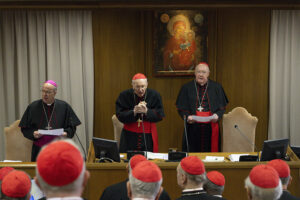
Catholic cardinals from around the world will begin voting for a new pope in the Sistine Chapel on Wednesday afternoon, under Michelangelo’s famous ceiling fresco. This is the largest and possibly most unpredictable papal election in history.


Pope Francis, who passed away last month at 88, left behind a college of cardinals that is diverse and divided. Some cardinals share his progressive views, while others want to reverse his changes.
There are 133 cardinals who can vote for the new pope. Since April 28, they have been meeting daily to discuss their visions for the future of the church. However, there seems to be some confusion among them, as Ignatius Suharyo Hardjoatmodjo, the archbishop of Jakarta, mentioned after listening to 50 cardinals. “We’ve heard many opinions, and it’s hard to come to a conclusion,” he said.
On Tuesday, the cardinals had their final meeting before going to their rooms at Casa Santa Maria, where they will be cut off from the outside world. They must give up their phones and only leave for voting sessions at the Sistine Chapel. Everyone involved, from cardinals to Vatican staff, has sworn an oath of secrecy.
Each day, the cardinals will vote twice: once in the morning and once in the afternoon. After each vote, black smoke means no pope has been chosen, and white smoke means a new pope has been selected. If it takes too long to decide, the cardinals will take a break after three days of voting.
Before Pope Francis passed, there was already much speculation about who might succeed him. Some names have gained more attention recently, including Robert Prevost, a moderate cardinal from the US, who is praised for his good judgment and listening skills. Other front-runners include Pietro Parolin, the Vatican’s secretary of state, and Luis Antonio Tagle from the Philippines, who is known as “the Asian Francis.” However, both have faced criticism over handling cases of clerical sexual abuse.
In addition to these moderate candidates, there are other cardinals with more progressive views, such as Matteo Zuppi from Italy, Pierbattista Pizzaballa from Jerusalem, and Jean-Claude Hollerich from Luxembourg. On the traditionalist side, there are Péter Erdő from Hungary and Robert Sarah from Guinea, who have been critical of Pope Francis’s approach.
However, as history shows, the pope chosen is often someone who wasn’t seen as a front-runner at first. For example, Pope Francis himself wasn’t expected to be elected in 2013, but he became pope by the end of the conclave.
Read More: Trump as Pope? The AI Papal Image That Sparked Global Outrage
One thing most cardinals agree on is that the new pope needs to be someone who can guide the church during challenging times, helping people facing global crises. The cardinals also emphasized their commitment to supporting the new pope.
Andrea Vreede, a Vatican journalist, said the cardinals are entering the conclave believing that God has already chosen the next pope. They just need to figure out who it is. The outcome of the election is hard to predict because many of the cardinals don’t know each other well. Pope Francis didn’t hold regular meetings with cardinals, so they didn’t have a chance to collaborate much.
Despite their differences, the cardinals agree that the conclave should be quick, lasting no more than three to four days. Severina Bartonitschek, another Vatican journalist, believes the cardinals already have someone in mind, and that the new pope’s main job will be to unite the church. This will be especially important given the church’s ongoing challenges, like addressing clerical abuse cases. The new pope will need to tackle these issues fearlessly.












